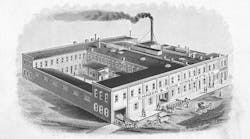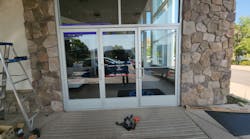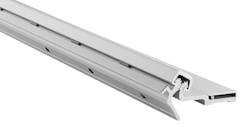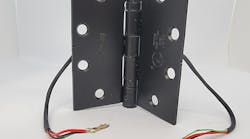Locksmiths use power transfer products quite frequently. Sometimes they are used to bring switch contacts from an exit device off a door, or power to a latch retraction exit device, or most recently to bring maglock power and gate position sensor from a swinging gate.
Frequently, a customer specifies that any added hardware be discrete. This means aesthetically pleasing, and also hopefully, less vulnerable to attack. If it not obtrusive, it will be less likely to draw attention to itself, as a target for destruction.
Door cords are nothing new. One of my earliest recollections of a door loop was the kind used for security on roll-up doors. It fastened on the door and the stationary door frame, and had interlocking plugs which connected the two halves. Each interlocking plug had a reinforcing chain that acted as a strain relief, so that in the event of a forced entry where the connectors weren't manually separated prior to opening the door, or if the alarm owner simply forgot to separate the connectors and yanked the door open; the door loop would not self destruct.
Another classic was the coiled cord, which was typically used on tilting casement windows with on-glass security protection. The circuit would not be interrupted regardless of the window position.
The coiled cord was also referred to as a traveler cable. These were used on overhead and sliding doors, and on elevator gondolas, as well as on intercoms and cameras.
So power transfer devices are used to carry power to or monitor hardware on a moving door. In most cases they provide uninterrupted connections, regardless of the door's position.
SECURITECH POWER TRANSFER SYSTEM
One notable exception is a power transfer device used for electromagnetic locking devices which is offered by Securitech . The unique Securitech Yamaka system is installed at the top of the door and the header.
The door module includes two spring loaded stainless steel tips. The header plate includes two stainless steel transfer strips. When the door closes, the tips mate with the strips. Power (or signal) can be transferred to the control trim or other device.
Features:
• Concealed Module Installs Easily Into Aluminum Or Hollow Metal Doors
• Transfers Low Voltage Or Signal From Switch Via 18 Gauge Wire
• Stainless Steel Transfer Tips & Plates To Resist Rust & Corrosion
• Tested To Over 2 Million Cycles
• Wide Transfer Strips For Easy Installation
• Adjustable Slot Allows Door Module To Be Raised In Case Door Shifts
• Does Not Require Special Door Or Frame Preparation
• Ideal For Use with Electrically Released Trim
• May Be Used With Other Electrified Products - (Electric Strikes On Inactive Leaf)
ELECTRIFIED MINI-HINGES
Securitech electrified mini-hinges are another unique approach to power transfer, which brings distinct advantages over other solutions for doors outfitted with continuous hinges.
The electrified mini-hinge is installed above the full length hinge, but 1-½” is cut from the full length hinge to allow space for the mini-hinge. Power is transferred from the frame to the door invisibly.
Features:
• Allows Easy Testing Of Electric Locking Systems Without Removing Door
• Installs Above Full Length Continuous Hinge
• Choose From Full Mortise, Half- Surface & Full Surface Models
• Wire Transfer Through The Bearing Eliminates Pinching & Wear & Tear
• Channel Drilled In Hinge Section For Clean Wire Routing
• Tested For Over 1 Million Cycles
• Special High Tensile Wire Resists Fraying & Cracking
For more information, visit www.securitech.com.
KEEDEX DOOR LOOPS
Keedex offers a full line of armored door loops. The 3/8” I.D. (inner diameter) armored model is available in a number of powder coated finishes which eliminates trying to spray paint them on-site. And the powder coating doesn't come off. The main advantage is the large diameter which allows room for a variety of wire sizes and numbers of conductors to suit your application. The splice boxes are roomy and facilitate drilling a large hole into the mounting surface to pass the wires through, and splicing.
Keedex also has a line of stainless steel armored door loops which are all-metal and available in various lengths and in both ¼” and 3/8” I.D. flexible conduit. The most unique aspect of these loops is the stainless steel cap on each end which attaches the loop to the door and to the frame. With proper fasteners, this product is rust proof and highly vandal-resistant.
Additional Keedex products include locksmithing supplies and a wide assortment of weldable lock boxes, which enable the installation of strikes, access control and exit bars on gates. For information, visit www.keedex.com.
VON DUPRIN POWER TRANSFERS
The Von Duprin EPT-2 and EPT-10 are high-end concealed power transfers you use when only the best will do. This device is invisible when the door is closed, and offers a high degree of protection to the wiring even while the door is ajar.
Although the EPT is extremely versatile, it doe have a few limitations as to where it can be used. EPT can be used for doors 1 ¾” minimum with:
. 0 – 180-degree opening with up to 5. butt hinges
. 0 - 180-degree opening with up to ¾” offset pivots
. 0 - 130-degree opening with 5 ½” butt hinges
. 0 - 110-degree opening with 6” butt hinges
EPT cannot be used for: 1 ½” offset pivots, larger than 6” butt hinges, pocket pivots, swing clear hinges, center hung doors or (center pivot) balanced doors.
Electrical ratings are
EPT2: Two 18AWG wires, Max. Rating: 24VDC, 5A or 120VAC NEC
EPT10: Ten 24AWG wires, Max Rating: 24VDC, 1A
Installing an EPT on a ‘factory prepped” door would be a very simple task requiring wire splicing and screw tightening. But how about getting the wire through the door and the frame?
However, my typical installation is on un-prepped doors, which people are using while I'm installing. The three types of doors I've done are:
SOLID WOOD; Requires hollowing and mortising. Although wood is easier to cut into than metal, I think I still prefer to work on metal
HOLLOW METAL (STEEL) Sometimes they're laminated or otherwise reinforced on the edge where I want to place the EPT. And the jambs are often reinforced with spurs or filled with concrete. Sometimes the concrete has diamond hard gravel mixed in. For the mounting in the door, you need to fabricate offset flanges. If the steel is really thick, they don't need to be that offset. I think I've adapted pre-manufactured tabs made for door strikes etc
I have also chopped up one of the metal back boxes supplied with the EPT. At least it's the right width.
I do my cutting of the major rectangle with a rotary cutting wheel. Sometimes I use a Dremel , sometimes a normal right angle grinder with the appropriate carbide disk and sometimes a die-cutter. There is never enough room to position a jig saw for the job, and never enough depth in the frame to accommodate the blade throw either.
Define the corners with a drill bit, using eye protection and maybe a breathing filter if there is mortar or whatever flying around, and shine a good work light on the object. Then try to clear the area and warn innocent bystanders. On some occasions they'll hang a sticker that indicates that a fire watch is required and get someone to stand watch because of the possibility of a fire starting.
Usually the hole needs to be fine tuned a little bit, sides enlarged, corners squared, sharp edges deburred , etc.
ALUMINUM: Aluminum storefronts go the fastest because the aluminum is comparatively soft and easy to cut, and the frames are not usually filled with concrete. Aluminum tends to load some types of cutting tools, and produces shards which can pierce the skin and somehow become infected.
Clients like the appearance of the EPT. They are also very robust and dependable.





